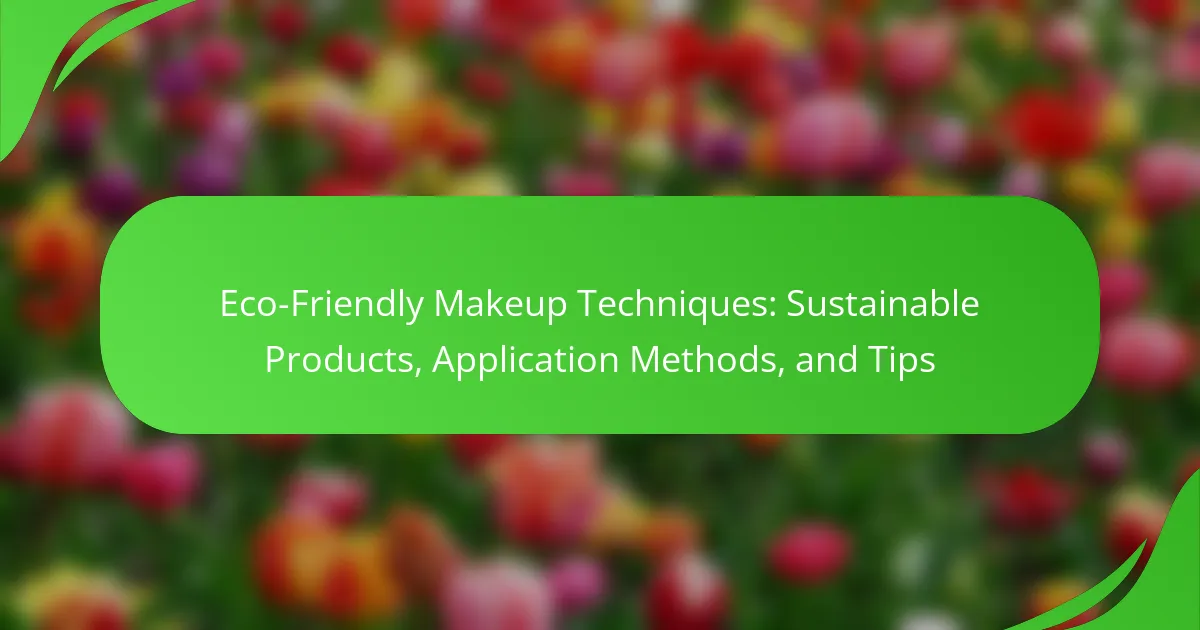Eco-friendly makeup techniques prioritize sustainable products and methods that reduce environmental impact. Key components include biodegradable or recyclable packaging, cruelty-free formulations, and natural, non-toxic ingredients. Application methods such as using biodegradable brushes and reusable cotton pads further enhance sustainability. The article also emphasizes the importance of educating consumers about responsible disposal and selecting multi-use products to minimize waste. Brands specializing in eco-friendly options, like RMS Beauty and Ilia Beauty, are highlighted for their commitment to ethical practices and sustainability in beauty routines.

What are Eco-Friendly Makeup Techniques?
Eco-friendly makeup techniques involve using sustainable products and methods that minimize environmental impact. These techniques include using biodegradable or recyclable packaging. They also encompass choosing cruelty-free brands that do not test on animals. Additionally, eco-friendly makeup may consist of natural ingredients that are non-toxic and organic. Techniques can also involve using reusable applicators instead of disposable ones. Another aspect is opting for minimal makeup to reduce waste. Educating consumers about sustainable practices further supports eco-friendly makeup. Collectively, these methods promote a healthier planet while enhancing beauty routines.
Why are Eco-Friendly Makeup Techniques important?
Eco-friendly makeup techniques are important because they minimize environmental impact. Traditional makeup often contains harmful chemicals that can pollute ecosystems. Eco-friendly products use natural ingredients that are biodegradable and less toxic. This reduces the risk of water contamination and soil degradation. Additionally, sustainable packaging helps decrease plastic waste. Studies show that the cosmetics industry contributes significantly to global waste. By adopting eco-friendly practices, consumers can support sustainability and promote healthier beauty choices.
How do Eco-Friendly Makeup Techniques benefit the environment?
Eco-friendly makeup techniques benefit the environment by reducing waste and minimizing chemical pollution. These techniques often use sustainable ingredients that are biodegradable. They decrease reliance on synthetic chemicals that can harm ecosystems. Many eco-friendly brands prioritize recyclable or compostable packaging. This helps to reduce landfill contributions. Additionally, these practices promote cruelty-free testing methods. According to a study by the Environmental Working Group, conventional cosmetics can contain harmful substances. Switching to eco-friendly options can mitigate these risks. Overall, adopting these techniques supports a healthier planet.
What are the health benefits of using Eco-Friendly Makeup Techniques?
Eco-friendly makeup techniques offer several health benefits. They often contain natural ingredients. These ingredients reduce the risk of skin irritation. Many conventional products include harmful chemicals. Eco-friendly options typically avoid these toxic substances. This results in fewer allergic reactions for users. Additionally, they are less likely to disrupt hormonal balance. Many eco-friendly brands prioritize skin health in their formulations. Research indicates that natural ingredients can enhance skin vitality. For example, ingredients like shea butter and coconut oil provide moisture. Overall, using eco-friendly makeup can promote healthier skin over time.
What are the core principles of Eco-Friendly Makeup Techniques?
The core principles of eco-friendly makeup techniques focus on sustainability and environmental impact. These techniques prioritize the use of natural, organic ingredients. They aim to reduce waste through minimal packaging and recyclable materials. Eco-friendly makeup also emphasizes cruelty-free practices, avoiding animal testing. Furthermore, these techniques advocate for transparency in ingredient sourcing and production processes. They promote products that are free from harmful chemicals and toxins. Lastly, eco-friendly makeup encourages consumers to support brands committed to ethical practices.
How do sustainable sourcing and production practices influence Eco-Friendly Makeup?
Sustainable sourcing and production practices significantly influence Eco-Friendly Makeup by ensuring ethical ingredient procurement and reducing environmental impact. These practices focus on using natural, renewable materials sourced from sustainable farms. For instance, brands may utilize plant-based ingredients that are grown without harmful pesticides. This approach minimizes ecological harm and promotes biodiversity.
Production methods also play a crucial role. Eco-Friendly Makeup brands often adopt processes that reduce water usage and energy consumption. According to a study by the Environmental Protection Agency, sustainable manufacturing can decrease greenhouse gas emissions by up to 50%. Additionally, eco-friendly packaging, often made from recycled or biodegradable materials, further enhances sustainability.
These practices appeal to environmentally conscious consumers. They support brands that prioritize transparency and ethical standards. As a result, sustainable sourcing and production practices not only enhance the product’s environmental profile but also strengthen consumer trust and brand loyalty.
What role do natural ingredients play in Eco-Friendly Makeup Techniques?
Natural ingredients are essential in eco-friendly makeup techniques. They reduce environmental impact compared to synthetic alternatives. Natural components often have biodegradable properties. This means they break down more easily in nature. Additionally, they tend to be less harmful to skin and health. Many consumers prefer natural ingredients for their perceived safety. Studies show that these ingredients can provide skin benefits, such as hydration and nourishment. Eco-friendly brands often emphasize transparency in sourcing these natural ingredients. This approach builds consumer trust and promotes sustainable practices in the beauty industry.

What Sustainable Products are Available for Eco-Friendly Makeup?
Sustainable products available for eco-friendly makeup include biodegradable packaging, natural pigments, and cruelty-free formulations. Biodegradable packaging reduces plastic waste and is made from materials that decompose naturally. Natural pigments are derived from plant sources, minimizing synthetic chemicals in cosmetics. Cruelty-free formulations ensure no animal testing is involved, aligning with ethical standards. Brands like RMS Beauty and Ilia Beauty specialize in these sustainable options. Research shows that using eco-friendly makeup can significantly lower environmental impact. A study by the Environmental Working Group highlights the benefits of using natural ingredients for both health and sustainability.
How do I choose sustainable makeup brands?
To choose sustainable makeup brands, look for those with eco-friendly ingredients and ethical sourcing. Research brands that prioritize natural, organic, and biodegradable components. Check for cruelty-free certifications, indicating no animal testing. Examine packaging for recyclability or use of sustainable materials. Review company transparency regarding their supply chain and environmental impact. Seek brands that engage in social responsibility initiatives or support local communities. Consider certifications like USDA Organic or Fair Trade as indicators of sustainability. Brands that openly share their sustainability practices often demonstrate a genuine commitment to the environment.
What certifications should I look for in sustainable makeup products?
Look for certifications such as USDA Organic, Leaping Bunny, and EcoCert in sustainable makeup products. USDA Organic certification ensures products are made with organic ingredients and free from harmful chemicals. Leaping Bunny certification guarantees that no animal testing is conducted during product development. EcoCert verifies that products meet strict environmental and social criteria. These certifications provide assurance of sustainability and ethical practices in makeup formulations.
Which ingredients should I avoid in conventional makeup products?
Avoid ingredients like parabens, sulfates, and phthalates in conventional makeup products. Parabens are preservatives linked to hormonal disruptions. Sulfates can strip skin of natural oils and cause irritation. Phthalates are associated with reproductive issues and hormone disruption. Additionally, avoid synthetic fragrances, which can trigger allergies and sensitivities. Heavy metals like lead and mercury may be present in some products and pose health risks. Research indicates that these ingredients can have adverse effects on health and the environment. Choosing makeup without these harmful substances promotes better skin health and sustainability.
What types of sustainable makeup products are there?
Sustainable makeup products include various types designed to minimize environmental impact. These products typically feature natural ingredients, biodegradable packaging, and cruelty-free testing methods. Examples include organic foundations made from plant-based ingredients. Eco-friendly lipsticks often use sustainable oils and waxes. Mineral makeup is another option, as it contains natural minerals and avoids harmful additives. Refillable compacts are increasingly popular, allowing users to reduce waste. Vegan makeup products exclude animal-derived ingredients, promoting ethical consumption. Brands focused on sustainability often prioritize transparency in sourcing and manufacturing processes.
What are the benefits of using organic versus conventional makeup?
Organic makeup offers several benefits over conventional makeup. Organic products typically contain natural ingredients. These ingredients are less likely to cause skin irritation. Conventional makeup often includes synthetic chemicals. These chemicals can lead to allergic reactions and skin issues. Organic makeup is often free from harmful additives. This can promote better skin health in the long term. Additionally, organic makeup is usually more environmentally friendly. The production of organic products often uses sustainable farming practices. This reduces the impact on ecosystems compared to conventional methods.
How can I identify cruelty-free makeup products?
To identify cruelty-free makeup products, look for specific certifications on packaging. Common labels include the Leaping Bunny logo and PETA’s cruelty-free bunny. These certifications indicate that the products were not tested on animals. Research the brand’s policies on animal testing. Many brands provide this information on their websites. Additionally, check if the brand is listed on cruelty-free databases. Websites like Ethical Elephant and Cruelty-Free Kitty offer comprehensive lists. Finally, inquire directly with the brand if you have doubts. Transparency in animal testing policies is a good indicator of cruelty-free practices.

What Application Methods Enhance Eco-Friendly Makeup Techniques?
Eco-friendly makeup techniques can be enhanced by using specific application methods. These methods include using biodegradable brushes and tools. Biodegradable materials reduce waste in landfills. Additionally, applying products with fingers minimizes the need for disposable applicators. This approach also promotes a more natural look. Another method is to use reusable cotton pads for makeup removal. This reduces single-use waste significantly. Furthermore, airbrush techniques can apply makeup with minimal product waste. These methods collectively support sustainability in beauty routines.
How can I apply Eco-Friendly Makeup effectively?
To apply eco-friendly makeup effectively, start with clean, moisturized skin. Use a natural primer to create a smooth base. Select eco-friendly foundation that matches your skin tone. Apply it with a brush or sponge for even coverage. Use biodegradable or reusable applicators to minimize waste. For eyes, choose organic eyeshadows and natural mascaras. Blend colors gently for a natural look. Finish with a sustainable setting spray to lock in your makeup. This method ensures you use products that are better for the environment while achieving a polished appearance.
What tools are best for applying sustainable makeup products?
The best tools for applying sustainable makeup products include biodegradable brushes, reusable sponges, and eco-friendly applicators. Biodegradable brushes are made from sustainable materials and reduce plastic waste. Reusable sponges, often made from natural materials, minimize single-use waste. Eco-friendly applicators, such as bamboo or recycled materials, are also effective. These tools allow for precise application while supporting sustainability. Using these tools aligns with eco-friendly practices in the beauty industry.
How can I minimize waste during makeup application?
Use reusable tools to minimize waste during makeup application. Opt for brushes and sponges that can be cleaned and reused. This reduces the need for disposable applicators. Choose multi-use products to limit the number of items needed. For example, a lip and cheek tint serves two purposes. Store products properly to prevent spoilage and waste. Avoid excess product by using small amounts at a time. This practice also promotes a more natural look. Lastly, recycle packaging whenever possible to further reduce environmental impact.
What are some common mistakes to avoid with Eco-Friendly Makeup?
Common mistakes to avoid with eco-friendly makeup include overlooking ingredient transparency. It is essential to check for harmful chemicals, even in eco-friendly products. Another mistake is assuming all natural products are safe for all skin types. Natural ingredients can still cause allergic reactions. Failing to consider packaging is also a common error. Eco-friendly makeup should come in sustainable packaging to minimize waste. Additionally, consumers often neglect to research brands’ sustainability practices. Not all brands claiming to be eco-friendly follow ethical sourcing or production methods. Lastly, many people forget to properly store eco-friendly makeup. Improper storage can reduce the product’s effectiveness and lifespan.
How can I ensure my makeup lasts longer while using sustainable products?
To ensure your makeup lasts longer while using sustainable products, start with a clean and moisturized face. Use a primer specifically formulated for longevity. Sustainable primers often contain natural ingredients that enhance adherence. Opt for long-lasting, eco-friendly foundations that provide good coverage. Look for products with a matte finish to reduce shine throughout the day. Set your makeup with a natural setting spray to lock in the look. Choose sustainable powders to absorb excess oil and provide a matte finish. Reapply eco-friendly products as needed for touch-ups. Studies show that using these techniques can significantly improve makeup longevity.

What Tips Can Help Improve My Eco-Friendly Makeup Routine?
To improve your eco-friendly makeup routine, focus on using sustainable products. Choose brands that prioritize eco-friendly packaging and ingredients. Look for makeup made from natural, organic materials. Avoid products with harmful chemicals and synthetic additives. Opt for refillable or recyclable packaging to minimize waste. Prioritize cruelty-free brands that do not test on animals. Incorporate multi-use products to reduce the number of items you need. Educate yourself on proper disposal methods for makeup products to ensure they are disposed of responsibly. By following these tips, you can enhance your eco-friendly makeup routine effectively.
How can I create a sustainable makeup routine?
To create a sustainable makeup routine, start by choosing eco-friendly products. Look for brands that use natural ingredients and sustainable packaging. Avoid products with harmful chemicals and microplastics. Opt for multi-use products to reduce waste. Implement a minimalistic approach by selecting essential items only. Recycle or repurpose empty containers whenever possible. Educate yourself on the environmental impact of makeup brands. Supporting companies with ethical practices helps promote sustainability in the beauty industry.
What are some easy swaps to make my makeup routine more eco-friendly?
Use reusable makeup remover pads instead of disposable cotton pads. This reduces waste significantly. Opt for biodegradable makeup wipes instead of traditional ones. They break down naturally in landfills. Choose refillable makeup containers over single-use packaging. This minimizes plastic waste. Switch to cruelty-free brands that prioritize sustainable practices. Many of these brands utilize eco-friendly ingredients. Consider mineral-based makeup products. They often contain fewer harmful chemicals. Use natural brushes made from sustainable materials instead of synthetic ones. This supports eco-friendly production methods.
How can I properly dispose of or recycle old makeup products?
To properly dispose of or recycle old makeup products, first check local regulations regarding cosmetic waste. Many municipalities have specific guidelines for hazardous waste disposal. Remove any remaining product from containers to minimize waste. Recycle packaging made of glass, metal, or certain plastics if accepted by your local recycling program. Some brands offer take-back programs for their products. Research these initiatives to ensure proper recycling. Additionally, consider donating unopened products to shelters or organizations that accept cosmetic donations. Following these steps ensures environmentally responsible disposal of makeup products.
What are the best practices for maintaining Eco-Friendly Makeup products?
Store eco-friendly makeup products in a cool, dry place. This helps to preserve their natural ingredients. Avoid exposure to direct sunlight, which can degrade product quality. Use clean tools to apply makeup to prevent contamination. Regularly clean brushes and applicators with gentle soap or alcohol. Check expiration dates to ensure product effectiveness and safety. Discard products that show changes in color, smell, or texture. Recycle packaging when possible to minimize environmental impact. Opt for refillable containers to reduce waste and promote sustainability.
Eco-friendly makeup techniques focus on using sustainable products and methods that minimize environmental impact, including biodegradable packaging and cruelty-free formulations. The article outlines the importance of these techniques for reducing waste and chemical pollution, highlighting the health benefits of natural ingredients. It also discusses sustainable sourcing practices, application methods that enhance eco-friendliness, and tips for creating a sustainable makeup routine. Key certifications and common mistakes to avoid are addressed, providing a comprehensive guide for consumers looking to adopt eco-friendly makeup practices.


